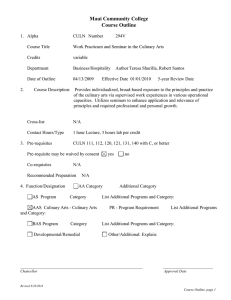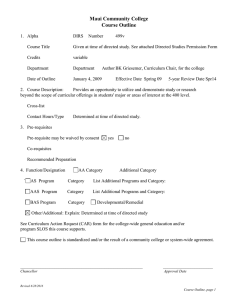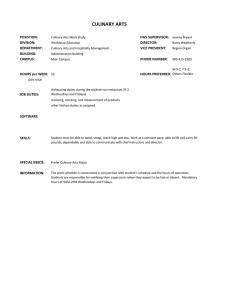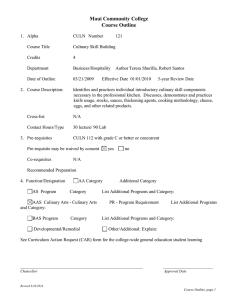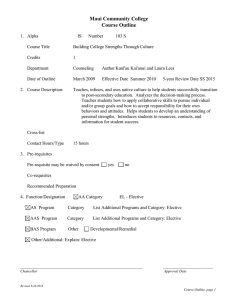2008.83 - Culinary Arts (CULN) 293V: Culinary Arts Field Experience, Course Outline
advertisement
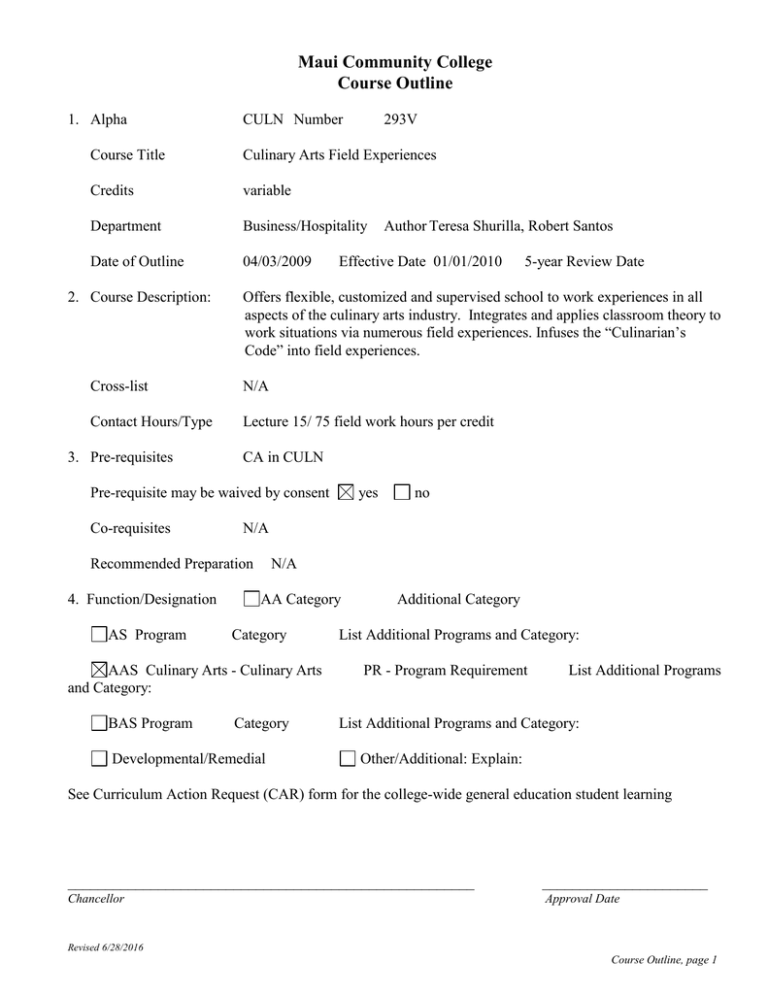
Maui Community College Course Outline 1. Alpha CULN Number 293V Course Title Culinary Arts Field Experiences Credits variable Department Business/Hospitality Date of Outline 04/03/2009 2. Course Description: Author Teresa Shurilla, Robert Santos Effective Date 01/01/2010 Offers flexible, customized and supervised school to work experiences in all aspects of the culinary arts industry. Integrates and applies classroom theory to work situations via numerous field experiences. Infuses the “Culinarian’s Code” into field experiences. Cross-list N/A Contact Hours/Type Lecture 15/ 75 field work hours per credit 3. Pre-requisites CA in CULN Pre-requisite may be waived by consent Co-requisites AS Program no N/A AA Category Category AAS Culinary Arts - Culinary Arts and Category: BAS Program yes N/A Recommended Preparation 4. Function/Designation 5-year Review Date Category Developmental/Remedial Additional Category List Additional Programs and Category: PR - Program Requirement List Additional Programs List Additional Programs and Category: Other/Additional: Explain: See Curriculum Action Request (CAR) form for the college-wide general education student learning ______________________________________________________ ______________________ Chancellor Approval Date Revised 6/28/2016 Course Outline, page 1 2 outcomes (SLOs) and/or the program learning outcomes (PLOs) this course supports. This course outline is standardized and/or the result of a community college or system-wide agreement. Responsible committee: PCC 5. Student Learning Outcomes (SLOs): List one to four inclusive SLOs. For assessment, link these to #7 Recommended Course Content, and #9 Recommended Course Requirements & Evaluation. Use roman numerals (I., II., III.) to designate SLOs On successful completion of this course, students will be able to: I. Describe and practice necessary skills to seek and secure pertinent employment II. Apply classroom knowledge, skills and competencies in the workplace III. Clarify personal career goals and aspirations IV. Discuss interrelationships between all culinary departments at the workplace 6. Competencies/Concepts/Issues/Skills For assessment, link these to #7 Recommended Course Content, and #9 Recommended Course Requirements & Evaluation. Use lower case letters (a., b.…zz. )to designate competencies/skills/issues On successful completion of this course, students will be able to: a. Describe and utilize the skills needed to seek, secure and keep a job b. Describe the technical and personal skills required of workers in the culinary arts industry c. Identify the personal and professional qualities, attitudes and work habits required of culinary arts employees d. Apply classroom knowledge and skills in the workplace e. Perform the task required in the workstations assigned f. Discuss the interrelationships between all departments in the assigned workplace g. Explain the importance of lifelong learning in the constantly changing industry h. Complete and explain the importance of careful and accurate completion of work-related forms and reports i. Clarify career goals and aspirations j. List related professional organizations and be encouraged to attend a minimum of one meeting per organization k. Discuss the infusion of the “Culinarian’s Code” into all aspects of their work 7. Suggested Course Content and Approximate Time Spent on Each Topic Linked to #5. Student Learning Outcomes and # 6 Competencies/Skills/Issues 1-2 weeks Introduction and explanation of course requirements (a, b), (I) 2-3 weeks Job interviewing, resumes, employer expectations (b, c), (I, III, IV) 2-4 weeks Overview of industry employment opportunities (e, f, i), (I, IV) 2-3 weeks Professional organizations and affiliations (g, i, j, k), (IV) 2 weeks Discussion of the importance and application of various work related forms and reports (h), (IV) Revised 6/28/2016 course outline 3 2 weeks Importance of life-long learning and professional development in the culinary field (g, j, k), (IIV) 8. Text and Materials, Reference Materials, and Auxiliary Materials Appropriate text(s) and materials will be chosen at the time the course is offered from those currently available in the field. Examples include: Kitchen Confidential, Bloomsbury Appropriate reference materials will be chosen at the time the course is offered from those currently available in the field. Examples include: Appropriate auxiliary materials will be chosen at the time the course is offered from those currently available in the field. Examples include: 9. Suggested Course Requirements and Evaluation Linked to #5. Student Learning Outcomes (SLOs) and #6 Competencies/Skills/Issues Specific course requirements are at the discretion of the instructor at the time the course is being offered. Suggested requirements might include, but are not limited to: 10-15% Completion and fulfillment of training forms, agreements, plan and other documents, as assigned 50% Completion of documented field experiences 20% Completion of assignments 5% Attendance in required meetings and seminars scheduled with the coordinator 20% Supervisor’s Evaluation 5% Seminars, Meetings 10. Methods of Instruction Instructional methods will vary considerably by instructor. Specific methods are at the discretion of the instructor teaching the course and might include, but are not limited to: 1. 2. 3. 4. 5. 6. Field experiences Meetings Seminars Discussions Assignments Other methods as needed 11. Assessment of Intended Student Learning Outcomes Standards Grid attached 12. Additional Information: Revised 6/28/2016 course outline
